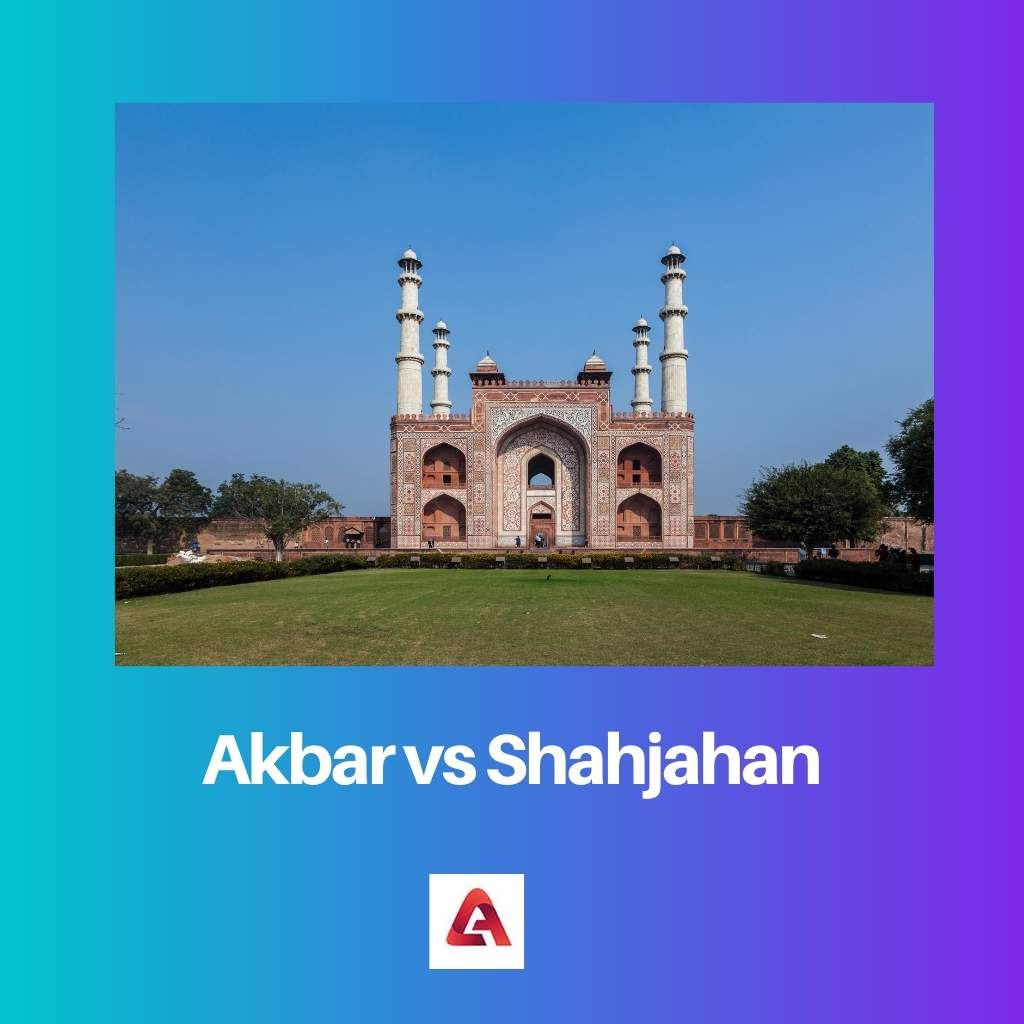The Mughal Empire was the initial modern empire of South Asia. It covered most of northern and central India and the entire Pakistan. The Mughal Empire had great emperors from 1526 to 1857. The two greatest emperors from this Mughal period are Akbar and Shahjahan.
Key Takeaways
- Akbar was the third Mughal emperor of India and ruled from 1556 to 1605.
- Shahjahan was the fifth Mughal emperor of India and ruled from 1628 to 1658.
- Akbar was known for his religious tolerance and innovative policies, while Shahjahan was best known for building the Taj Mahal.
Akbar vs Shahjahan
Akbar, the third emperor, supported the European School of painting apart from Mughal paintings, while Shah Jahan, the fifth emperor, hailed as the golden age of Mughal Architecture as he built many monuments in and around Delhi, the Taj Mahal which he built in the honour of his wife.

Akbar was the son of Humayun. He was the third Mughal emperor. Akbar was born on 15th October 1542 and died on 27th October 1605. Akbar extended the Mughal Empire and followed a centralized system of administration. He is known as a tolerant king. Akbar adored art, culture, and literature and created a huge library.
While Shahjahan was the son of Jahangir, he was the fifth Mughal emperor. Shahjahan was born on 5th January 1592 and died on 22nd January 1666. During his reign, the Mughal Empire achieved maximum cultural glory. He is known as a builder king due to his architectural and monumental achievements.
Comparison Table
| Parameters of comparison | Akbar | Shahjhan |
|---|---|---|
| Date and place of birth | 15th October 1542 in Umerkort, Sind | 5th January 1592 in Lahore, Pakistan |
| Year of throne ascension | 1556 at the age of 13 | 1627 at the age of 35 |
| Relationship | Grandfather of Shahjahan | Grandson of Akbar |
| Outlook | Promoted art, culture, literature, peace, unity, and tolerance | Promoted architectural growth |
| Successor | Akbar’s successor was Jahangir | Shahjahan’s successor was Aurangzeb |
| Date and place of death | 27th October 1605 at Fatehpur Sikhri | 22nd January 1666 at Agra Fort |
Who was Akbar?
Abul-Fath Jalal-ud-din Muhammad Akbar was known as Akbar. He reigned the Mughal empire from 1556 to 1605. Akbar was escorted by Bairam Khan during his reign. Akbar’s tomb is built in Sikandra, Agra. He was the son of Humayun and Hamida Banu Begum.
Akbar was a kind yet powerful king. He had extended his empire over the entire subcontinent. Though he was a follower of the Sunni Islam religion and promulgated Din-i-Ilahi, he appreciated other cultures too.
Akbar’s court was a centre of art and learning. He had several literary books translated into other languages and built numerous libraries, especially for women. The Indo-Persian ruler created a powerful military and social system. Thus, the empire grew in size and wealth rapidly.
Akbar was called “Shahanshah”, which means King of Kings in Persian. Akbar brought reformation to his army through the inculcation of cannons, forts, matchlocks, and elephants. He abolished the sectarian tax of Non-muslims and won the trust of the native public.
Akbar had a popular nickname of “The Great”, based on his achievement and efficient administration. Akbar followed the principle of “Sulh-e-Kul”, which means universal peace. Though a fierce warrior, he believed in unity, tolerance, and peace. He promoted the inclusion of diversity.
Who was Shahjahan?
Shahab-ud-din Muhammad Khurram was known as Shahjahan. ” Shahjahan” means King of the World in Persian. He reigned the Mughal empire from 1628 to 1658. He was the son of Jahangir and Jagat Gosain. Shahjahan’s chief minister and treasurer were Sheikh Farid, who founded Faridabad city.
Though a powerful military general, Shahjahan is known for his architectural achievements. His famous monuments include the Taj Mahal (which took twenty years to complete), Red Fort, Jama Masjid, Moti Masjid, Shalimar Gardens, Mahabat Khan Mosque, and large sections of Agra Fort and Lahore Fort. He had also built a peacock throne which was called Takht-e-Taus.
Apart from the monuments, he even owned the royal treasure and the precious Kohinoor stone. Shahjahan’s army had a huge infantry, artillerymen, musketeers, cannons, battleships, fortified walls, Marwari horses, Sowars, and other instruments of war.
During his reign, the Mughal Empire multiplied in revenue and attained stability. Shahjahan followed centralized administration and systematic court affairs. The Mughal Empire’s GDP (gross domestic product) grew from 22.7% to 24.4%.
During his reign, a famine broke out in the Deccan, and the subcontinent faced a huge crisis. Shahjahan was not quite tolerant towards other religions and had over 76 temples demolished.
Main Differences Between Akbar and Shahjahan
- Akbar was the third emperor of the Mughal Empire, while Shahjahan was the fifth emperor of the Mughal empire.
- Akbar’s father was Humayun, while Shahjahan’s father was Jahangir.
- Akbar was a patron of art, culture, unity, and tolerance, while Shahjahan was a patron of architecture and monuments.
- Akbar assumed the throne in 1556, while Shahjahan assumed the throne in 1628.
- Akbar was born in Umerkort (Sind), while Shahjahan was born in Lahore (Pakistan).
- Akbar was also called as Abul-Fath Jalal-ud-din Muhammad Akbar, Shahanshah Akbar-e-Azam, and Akbar-The Great, while Shahjahan was also called Shahab-ud-din Muhammad Khurram.




